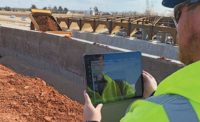In the view of Delaware Dept. of Transportation officials, being the second-smallest state in the nation gives the agency an advantage when it comes to moving projects forward and adopting innovative approaches.
Robert McCleary, chief engineer at DelDOT, says having a small staff streamlines the decision-making process. “If someone has a good idea and it’s well researched and we feel confident,” he says, “we generally can move forward with it.”
In recent years, the agency has broadened its use of alternative project delivery methods while regularly piloting design concepts and trying new materials and emerging technologies. Despite its size, the agency undertakes its share of major projects, including the $636-million U.S. 301 upgrade and expansion project that is set for completion in December. In light of its recent accomplishments—both big and small—ENR MidAtlantic named DelDOT its Owner of the Year.
While the state has megaprojects underway, McCleary is proud of its recent smaller efforts. In 2016, the state completed its first diverging-diamond interchange at State Route 72 and SR 1. The concept to reconfigure the roadway was drafted by DelDOT design staff, but let as a design-build project—a delivery method that was officially codified for use by DelDOT in 2015. Traffic studies showed that the concept would reduce wait times at the intersection by four minutes. It also saved money. McCleary says rebuilding that interchange would have cost about $20 million. “We did it for $7 million by mostly reconfiguring existing infrastructure,” he says.
The interchange concept is now being considered for other state projects, McCleary says.
DelDOT recently tested high-friction surface treatments (HFST) to help reduce accidents in areas where wet, snowy or icy pavement can be an issue. As of April 2017, the state had installed more than 33,396 sq yd of HFST at more than 20 locations. Data showed that the concept reduced roadway departure crashes by an average of 56% at those locations. The method is also significantly less expensive than other solutions, such as reconfiguring roadways. The initiative earned DelDOT a 2017 National Roadway Safety Award, co-sponsored by the Federal Highway Administration and the Roadway Safety Foundation.
The HFST pilot was delivered using open-end contracting, which is another of the agency’s alternative-delivery tools. Similar to federal indefinite-delivery-indefinite-quantity contracts, the method leverages on-call contractors to complete small projects.
Jennifer Cohan, DelDOT commissioner, sees alternative-delivery methods as a way to better serve Delaware residents and visitors. Cohan was installed as commissioner in 2015, serving previously as the director of the Delaware Division of Motor Vehicles. “We’re trying to be more nimble and work on projects more quickly,” she says.
The state is also currently piloting CM-GC delivery on three projects. The method allows the state to hire a contractor to work with the designer and DelDOT during the design phase to help identify risks and consult on costs and schedule. After the design is complete, the state negotiates a construction contract with the contractor. If the negotiation is successful, it can shave months off the time and effort typically expended for bidding.
The agency is also able to use the A + B bidding method, where “A” represents the bid and “B” is payments based on time used to complete a project.
Last year, DelDOT and Delaware Transit Corp. inked a public-private partnership with Colonial Parking and developer EDiS to build the Wilmington Transit Center. The project is set for completion in 2019.
Despite the number of delivery options available, traditional design-bid-build contracts cover the vast majority of DelDOT’s work, including the U.S. 301 project. Funding large projects, like 301, can be a challenge for the state. In FY 2018, DelDOT will leverage $238.6 million in state transportation funds and $297.7 million in federal funding for capital expenditures. On U.S. 301, DelDOT will use $211.35 million in federal TIFIA loans that will be paid back using the new alignment’s all-electronic tolling. To speed delivery and create more opportunities for contractors, the project is split into seven contracts that are being built concurrently.
Large projects can also stretch DelDOT’s internal resources, so the firm often brings in outside consultants for its design, construction management and inspection work. “By number of projects, we design about 60% of our projects in-house,” McCeary says. “By dollar value, 60% of the projects go out to consultants. Big projects are big money and would take my entire staff, so they have to be outsourced.”
AECOM has worked with the state almost continuously since the early 1990s. “They are very forward thinking,” says Bruce Kay, AECOM’s vice president of MidAtlantic construction services. “If there’s something out there that they think could deliver a project better and faster, they will try it.”
AECOM worked on the $38-million POW/MIA Parkway, a 3.2-mile alignment that was delivered in September—31 months after breaking ground. AECOM was part of another fast-moving DelDOT project that used accelerated bridge construction to re-deck a bridge on I-95 over SR 1/7. The project was delivered in one month, compared with an estimated 6- to 8-month schedule for conventional construction methods, Kay says.
In the coming years, technology may open new frontiers at DelDOT. Delaware could lead the nation in connecting vehicles to infrastructure through technology, says Cohan, who currently chairs the National Operations Center of Excellence, which focuses on transportation systems management and operations. Delaware is the lead state on a study of mileage-based user fees and plans to pilot mileage tracking in vehicles.
DelDOT is also looking to connect its Intelligent Transportation Systems to autonomous vehicles. As part of its initial efforts, the agency is working with the University of Delaware to test autonomous shuttles. “Delaware is poised to be a leader in this airspace,” Cohan says.
DelDOT’s Recent Accomplishments Include Both Large and Small Projects
U.S. 301: When completed in December, the $636-million U.S. 301 project will create a new 14-mile limited-access alignment that connects 301 at the Maryland border with State Route 1. The project will be the state’s first use of all electronic tolling.
POW/MIA Parkway: The $38-million project, which opened in late 2017, created a new 3.2-mile alignment that includes bicycle facilities, rail services and multiple pathways connected to park facilities, commercial centers and residential communities.
SR 72/SR 1 Diverging Diamond Interchange: DelDOT’s first use of a diverging diamond interchange. Completed in late 2016, the design-build project cost one-third the amount estimated to build a conventional cloverleaf interchange.





Post a comment to this article
Report Abusive Comment